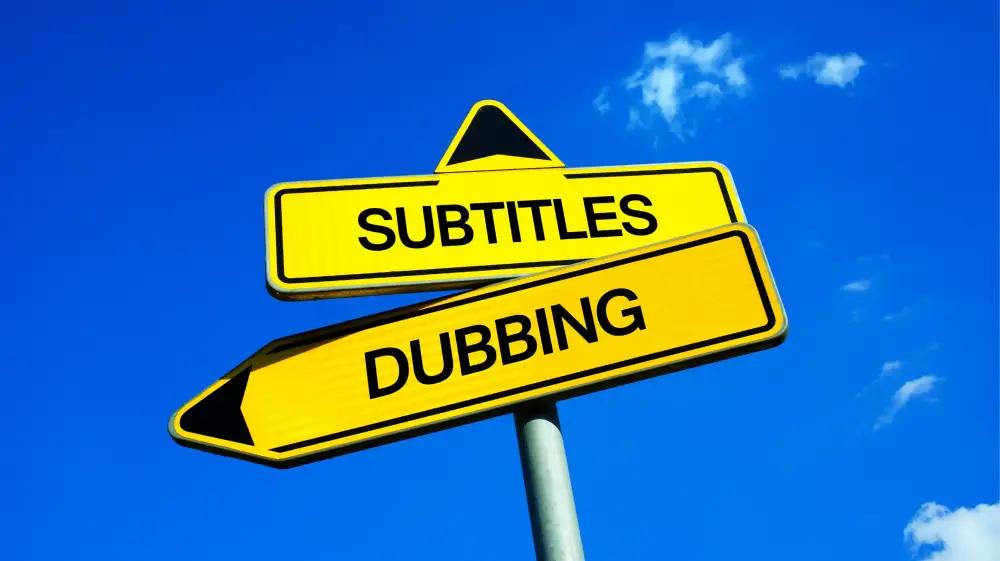Summary
Subtitling is the written translation of audiovisual content. Dubbing is the oral translation of audiovisual content that replaces the original speakers. Both subtitling and dubbing have many advantages and disadvantages. Individuals get to choose between both, and that is based on their preferences.
Get our subtitling and captions translation now
Subtitling definition
Subtitling means the translation of audiovisual content for people who don’t understand the spoken language. It is the written representation of audible content but in another language. It is used for so many reasons, and in all fields, including legal, medical, engineering, psychology, entertainment, and more. Audiovisual content can be a voice recording, a podcast, a video, a film, a series, a documentary, a lecture, a conference, etc. Subtitling is usually done by subtitlers who are translators who deliver the same meaning of the audiovisual content but in a different language.
Get our news translation now
Subtitling process
To be able to deliver professional subtitling results, one must follow certain steps for the subtitling process to be considered successful. These steps include 3 phases, they are:
Pre:
Before starting the subtitling process, the subtitler needs to be prepared.
- Quiet setting: Subtitlers must, first of all, choose a quiet work environment to be able to focus on the audiovisual file and translate it without any distractions or additional voices.
- Noise-canceling headphones: Subtitlers usually have noise-canceling headphones to be able to listen to audiovisual files without external noises.
- Foot pedals: Foot pedals help subtitlers be in control. They can pause, rewind, and resume the file they are working on.
- Dictionaries and glossaries: Specific dictionaries and glossaries help subtitlers look up terminologies and certain translations.
- Download the audiovisual file: Subtitlers download the audiovisual file, and after it is successfully downloaded, they can proceed.
- Watch or listen for the first time: This is the last step before starting. Subtitlers watch the audiovisual content or listen to it to make sure they understand it.
During:
After completing the pre-subtitling steps, subtitlers become ready to start.
- Translation: Subtitlers start translating the audiovisual file while paying close attention to details.
- Research: During the subtitling process, subtitlers conduct research to be able to find equivalent terms and words and to be able to accurately convey the meaning.
Beyond Subtitles: Exploring the Various Types of Audiovisual Translation
Post:
Once the subtitling process is done, comes the most important part.
- Proofread: Subtitlers are always called to proofread the translated content to be able to spot minor mistakes related to grammar, spelling, or punctuation. This also allows them to correct typos.
- Simulation: After proofreading the translated content, subtitlers watch or listen to the audiovisual file and read the translation at the same time to make sure that they haven’t missed anything and that the whole process was a success. The simulation session is a screening with the written subtitles on the screen as they will appear.
Advantages of subtitling
There are so many advantages when it comes to subtitling. Not to mention that individuals and businesses need it more as the days go by, for the benefits it has. These advantages include:
- Targeting the deaf and hard of hearing: Subtitles can be for the deaf and hard of hearing and have the same purpose as captions which target the ones who are unable to hear. But in the case of subtitling, it allows the deaf and hard of hearing to understand what is being said in another language.
- Learning new languages: Subtitles make it possible for individuals to learn a new language or to better understand the content that is in a language they don’t totally understand. While listening to the speakers and reading the translation at the same time, individuals can properly learn a new language.
- Understanding difficult accents: Even if individuals understand a language, speaking it in a different accent might result in incomprehensive words. For that reason, subtitles guarantee that viewers or listeners totally understand everything.
- Wider audience: Subtitles make it possible for foreigners to watch the content or listen to it even if they don’t understand its language. That way, audiovisual content can reach more audiences worldwide.
- Ability to follow: Most individuals have a hard time following long videos or audio, especially if they were in a language they barely understand. For that reason, subtitles are used to enhance focus.
- Important details: Subtitles include important details such as amounts, phone numbers, and addresses that make it possible for listeners and viewers to remember, especially if they aren’t fluent in the language of the audiovisual file.
Subtitling Made Simple: Tips and Techniques for Learning
Disadvantages of subtitling
Some believe that subtitles have negative effects on watchers and listeners. Subtitling, just like everything else, has disadvantages. These disadvantages include:
- Distractions: Subtitles might distract viewers or listeners from the action or the important things that are being displayed.
- Frustration: Due to the limited time on screen, sentences might be showing too fast and listeners or viewers might not be able to fully read what is being displayed on the screen. This more often than not leads to frustration, and at times, listeners and viewers might stop watching or listening because of this.
- Checking translation: Individuals might be tempted to check whether the translation is good or bad if they know the source language, which distracts them. Also, when subtitles are not done by professionals, they might include errors, and viewers or listeners will indirectly learn from them, especially if they don’t know the proper way to write. This will negatively affect their personal writing. Therefore, if not done by professionals, subtitles can worsen the situation, instead of making it better.
Get our audio transcription services now
Dubbing definition
Dubbing is the spoken translation of audiovisual content. It typically means changing the original speakers into other speakers in other languages. This is usually used in long series to spare viewers from reading subtitles. It is used in all fields such as entertainment, economics, science, and more.
It can be done for movies, videos, series, documentaries, interviews, conferences, etc. In the case of movies or series, it usually requires actors to be able to have the same effect on viewers. However, dubbing is first handled by translators who start by conveying the meaning from one language to another, and then the whole recording process begins.
Get our video transcription services now
Dubbing process
The process of dubbing requires so much work. First, the spoken content needs to be accurately translated from one language into another. More often than not, the translation process is adapted to the target culture in terms of the names of characters for example. Once the translation process ends, the selected candidates who will speak in the target language start by reading the translated version to make sure that the pronunciation is good and that they understand everything.
Once this is completed, actors or speakers can start recording. The recording process usually takes place in a studio. However, if individuals decide to refer to dubbing and want to do it themselves, they can record the translated content in a quiet place. After finishing the recording process, the editing process starts. This also includes making sure that everything is accurate and that the recorded version is synchronized with the original version and the lips of the original actors or speakers.
Breaking Barriers: Inspiring Interlingual Translation Examples
Advantages of dubbing
Dubbing, just like subtitling, has many benefits. Many people refer to dubbing and choose it over subtitling. Its benefits include:
- Enjoying in a language you understand: Watching a movie or listening to a podcast in your mother tongue can be much easier than having to read the subtitles at the same time.
- No distractions: Dubbing prevents distractions such as paying attention to subtitles while watching a series for example. You get to enjoy the series without having to read and watch it at the same time.
- Less frustration: Dubbing makes it possible for individuals to watch a video or to listen to audio without having to read fast to be able to understand. This results in less frustration and will make individuals enjoy the process more.
The Road to Professional Translation: Translation Methods
Disadvantages of dubbing
Dubbing has disadvantages just like anything else with pros and cons. The disadvantages include:
- Not learning new languages: Dubbing eliminates the chance of learning a new language or improving your language since the speakers talk in your mother tongue. Not to mention that you are missing out on a fun way to learn a new language which is by using subtitles.
- Not listening to original speakers: At times, the quality of the movie can be affected if you are unable to listen to the original speakers.
- Inaccurate time of speaking: Dubbing is not always a success and synchronizing what is being said might not match the time of speaking of the original speaker. This results in frustration and the viewers can be lost.
- Same speaker for many original speakers: Sometimes, the same speaker can be used for multiple original speakers which might be frustrating and the viewers have to pay extra attention to be able to identify the change of speakers.
- Strange viewing: Editors might not always succeed in synchronizing what is being said in a way that matches the movements of the mouth, which results in strange viewing.
Get our interpretation services now
Are subtitles better than dubbing?
Many believe that subtitles are better than dubbing since it offers additional benefits such as learning a new language and making it possible for the deaf and hard of hearing to understand what is going on. On the other hand, many others believe that dubbing is much easier and it doesn’t require much effort. They consider that it is much better to watch the video or listen to the audio without having to follow the subtitles at the same time. In the end, it’s a matter of preference. To each its own advantages and disadvantages which might be suitable for some and not suitable for others.
Why subtitles are better than dubbing?
Some consider that subtitles are way better than dubbing since their advantages include the ability to learn a new language by reading the translation of what is being said at the same time. Also, subtitling is believed to be more accurate than dubbing since dubs more often than not tend to alter the script to be able to have the audio and the mouth movements match. Not to mention that listening to audiovisual content in the source language is considered to be more enjoyable than having it dubbed.
Furthermore, subtitles offer the chance to learn the spelling of words in the target language which might be beneficial as well, and the fact that this lacks in dubbing renders subtitles better than dubbing for some. Moreover, subtitles make it possible for the deaf and hard of hearing to enjoy a movie or a podcast by having the captions translated.
Get a quote now and let our translators bridge the gap between languages!
Which is better watching a film with dubbing or with subtitles?
It all depends on the preferences of viewers. However, when it comes to a film, viewers usually tend to choose to dub since they are able to enjoy the movie. Subtitles can make it hard for people to watch and understand at the same time since they need to read the subtitles fast and focus on the frame of the movie itself at once. However, when it comes to people who want to learn a new language, it is definitely better to watch a film with subtitles, because dubbing does not offer this option.
In a nutshell, to be able to enjoy a film, people tend to choose to dub over subtitles to be able to focus on the movie itself. However, others tend to choose subtitles for the benefits they offer such as learning a new language and enjoying the film in its original form.
Upload your file now and watch it seamlessly transform into any language of your choice!






